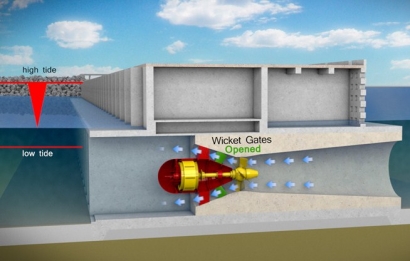
The £650 million tidal lagoon project for Swansea Bay has taken another step forward with the announcement of the start of formal public consultation beginning on Thursday 4th July with exhibitions in Swansea, Neath and Port Talbot.
Comments on the project must be received by 5th August 2013 to be considered during the preparation of the planning application which will itself be submitted in late 2013. An application to the Secretary of State for Energy and Climate Change, via the Planning Inspectorate, will be made for a Development Consent Order (DCO) under the Planning Act (2008) along with an application to Welsh Ministers via the Natural Resources Wales Marine Licensing Team (MLT) for a marine licence under the Marine and Coastal Access Act 2009.
The proposed lagoon will be built on the seabed south of and connecting to Swansea Docks (between the dredged channels of the Rivers Tawe and Neath) and on other land in the City and County of Swansea as well as in Neath Port Talbot County Borough. Work could potentially start as early as April 2015.
“The Project could provide up to 400GWh of reliable, low carbon electricity each year – enough for around 120,000 homes - making the Project a significant contributor to statutory, UK-wide, carbon reduction targets” said Head of Planning, Alex Herbert. “As a multi-million pound investment, it will also create economic opportunities for local people and businesses during construction and operation. It would incorporate a new visitor attraction with educational/sporting facilities and free, public access around a new seawall. However, the lagoon may also affect people, communities and the environment through, for example: visual impact; restrictions to navigation in Swansea Bay; ecological, water quality, coastal processes and other environmental impacts; and increased traffic during construction and operation phases. Therefore, it is vital that local communities have opportunities to contribute to the planning process.”
Construction will include offshore development work such as dredging as well as around 11 kilometres of new seawall connecting to the shore at two points on or close to Swansea Docks. The seawall will incorporate visitor and/or sporting facilities and concrete housings will contain around 16 electricity-generating turbines, electrical connections and other essential facilities. Onshore development will include various construction works such as site preparation and construction laydown areas and temporary facilities. Electricity transmission infrastructure will also be established in order to export generated electricity to Baglan National Grid Substation via underground cables.
Tidal Lagoon Swansea Bay Plc will be publishing a Preliminary Environmental Information Report (PEIR) and Non-Technical Summary (NTS). The PEIR will be available from 4th July 2013 and the company must consult on it before submitting its application for a DCO.
“Because of its size and location, the project falls within the scope of the Environmental Impact Assessment Directive, meaning that an Environmental Impact Assessment (EIA) must be carried out” Mr Herbert added. “When the EIA process is complete and we submit our application for a DCO, an ‘Environmental Statement’ (ES) will be produced. The ES sets out an assessment of a project’s likely significant environmental effects, along with any proposed mitigation. Swansea Bay’s tides are an outstanding and reliable source of natural energy. The Swansea Bay Tidal Lagoon project aims to harness this energy with the world’s first, purpose-built, tidal lagoon power plant. This will consist of a man-made seawall containing a series of turbines to capture energy from the motion of the tides and generate electricity. The proposed tidal lagoon is an exciting prospect for the local area and beyond. Not only will it provide renewable energy, but also diverse economic, social and cultural benefits. It will create jobs, promote tourism and foster education, sport and art at a range of new facilities.
A £2 million community share offer has also been launched which is open until 15th July
Further information:

